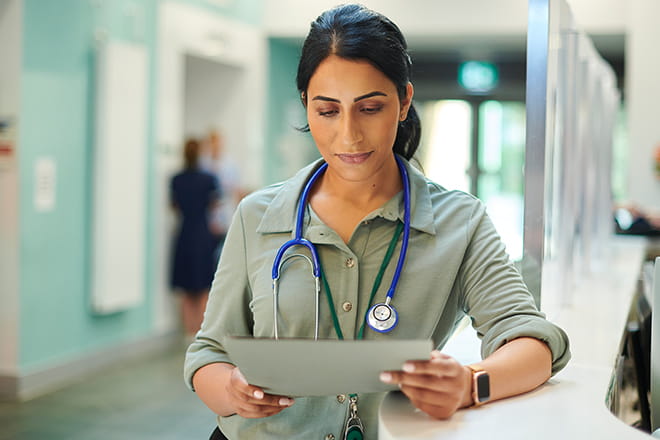The touchless world: Multisource evaluation collection in graduate medical education
By Farrah Cutia
As a graduate medical education (GME) professional, you’re likely familiar with the importance of multisource evaluation collection and feedback within residency and fellowship programs.
These evaluations are received from patients, families, nurses and other staff members. They’re a great way to assess trainee progress and performance in a given program and also help ensure that the trainee is meeting the required standards needed for success.
Here’s a look at why evaluations are important in GME programs and how institutions have adapted to a post-pandemic, contactless format:
Why multisource evaluations are important
Evaluations provide an objective assessment of progress in residency and fellowship programs, which is essential for learning and development.
Evaluations help trainees, program directors, faculty, staff, researchers and other healthcare team members gain insight into trainee and program performance. This allows the program leadership to track trainee progress and provide constructive feedback on any areas that show a need for improvement.
And because it offers a holistic perspective on a trainee's performance in a variety of domains, such as patient care, professionalism and communication, multisource feedback is particularly useful for professional development.
Additionally, evaluations can also act as essential documents for career advancement. Evaluations play an important part in assisting program directors in making judgments about the promotion or graduation of residents or fellows. They’re also often requested when applying for grants or awards or when looking for employment opportunities after graduation.
When compared to relying on subjective criteria such as faculty opinion, evaluating residents and fellows from many viewpoints helps provide more reliable evaluations. As a result, it helps ensure that correct, summative feedback is delivered at the conclusion of the training program.
Evaluations and other skills
Evaluations are used to not just gauge a trainee’s technical competence, but also their professional demeanour and interpersonal skills, which are essential components of the core competencies of a well-rounded physician.
It’s crucial for the success of trainees graduating from these postgraduate medical programs that the programs possess the capacity to correctly monitor their progress, quantify their performance and identify areas for their development.
How to get more from evaluations
The key to making the most out of multisource evaluations is preparation and distribution. It’s an accreditation requirement to collect and maintain several types of evaluations throughout GME training programs.
Prior to instructing residents and fellows to distribute their multisource evaluation forms, program leadership should ensure that the trainees have a complete understanding of what is expected of them during their training.
This will help them focus on specific skills and requirements that need improvement in the time leading up to the next evaluation period.
Post-pandemic evaluation challenges
In the GME field, evaluations play an essential role in residency and fellowship program accreditation. This is because they supply vital input to both the training program and its residents and fellows.
Regularly assessing trainee and program performance through evaluations can help ensure that trainees and programs stay on track with appointed goals
However, due to multiple hurdles such as restricted access to evaluation tools, high numbers of patients and staff members to evaluate and limited time for program managers to support the collecting process, it’s difficult to gather multisource evaluations.
This challenge is further illustrated by baseline data from institutions. The data show that a low number of multisource evaluations are completed and collected within an academic year.
Many institutions that have struggled with collecting enough multisource evaluation forms have used intervention strategies such as kiosks throughout their institution or paper mailings to evaluators. Data sources show that these interventions produced low percentages of evaluations returned.
Other residency management systems have added a public kiosk feature which enables the sharing of direct links, or QR codes, that direct users to a multisource evaluation form.
Using low-cost materials encoded with QR codes has simplified the evaluation collection process and has helped enable institutions and programs to gather more responses from a variety of sources. It’s also a user-friendly way to adhere to post-pandemic contactless standards.
Program leadership can also gain insight into how well trainees are performing in their program using digital interventions that can measure outcomes. Outcomes are the number of complete multisource evaluations received through the institution’s residency or program management system.
A strategy like this has proven to be advantageous for institutions. It makes it possible for them to obtain input from a wide variety of sources in a timely and anonymous manner. And it still guarantees that each resident and fellow can be recognized for their skills and work and be held accountable for their conduct.
As a result, it’s necessary for healthcare organizations to overcome obstacles, such as restricted access to evaluation tools and a lack of time, by putting resources into the development of effective systems for collecting these crucial evaluations.
If this is done, it will assist in guaranteeing that residents and fellows receive accurate and timely constructive feedback during their training term — a result that will improve outcomes not just for the trainees, but for the programs themselves.
How Wipfli can help
At Wipfli, our experienced team is ready to collaborate with your healthcare organization on a GME program. We have the depth to support you in all aspects, from feasibility studies to compliance.
Contact us today for more on how we can help you be successful with GME.
Sign up for more healthcare industry news, or continue reading:



